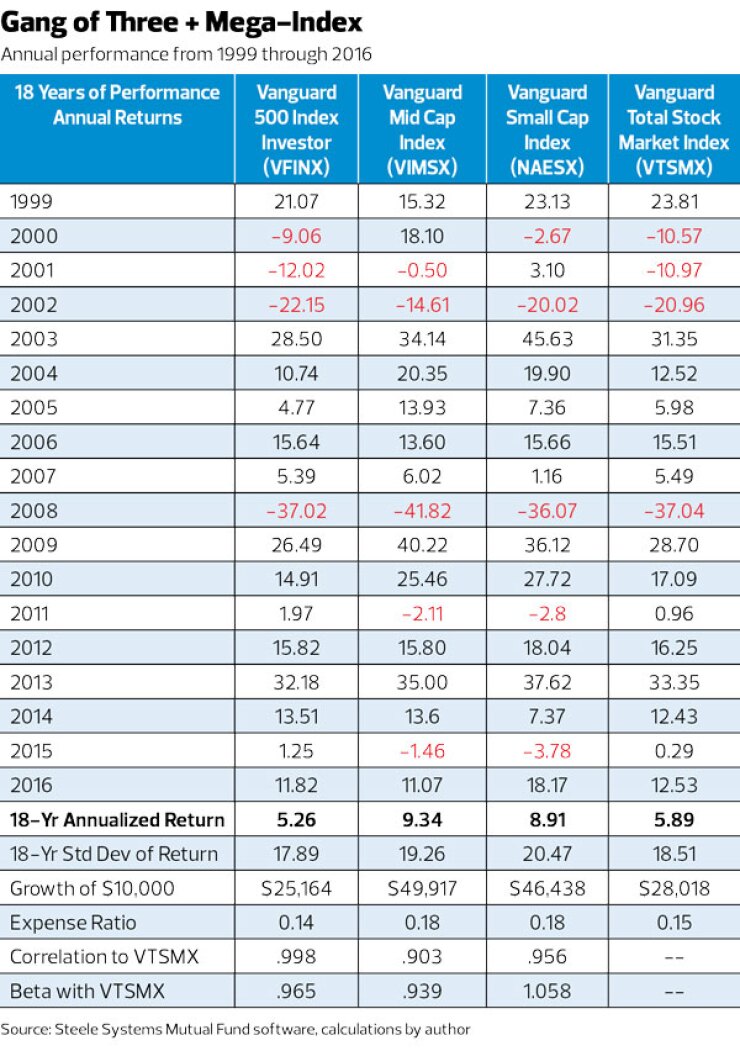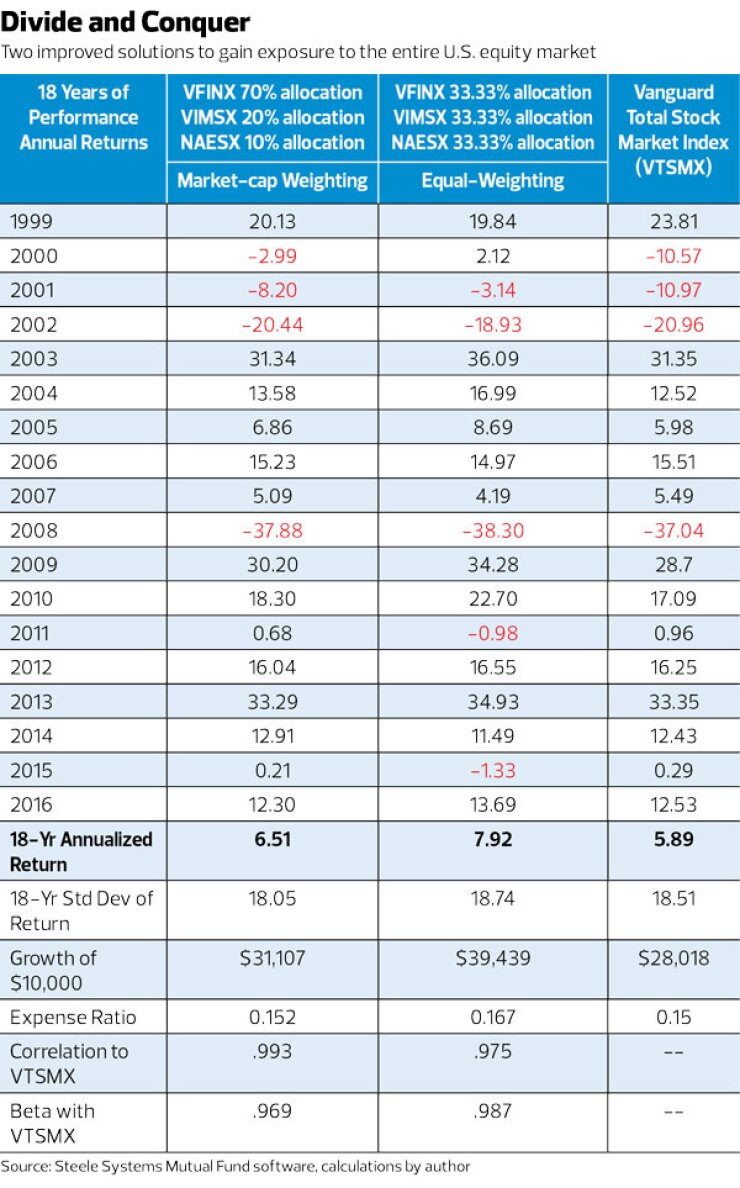For many investors, an important part of their overall investment portfolio is exposure to the U.S. equity market. Is this best accomplished by using a total stock market index fund or by buying a combination of several different index funds?
One-stop shopping has gained in popularity as an investing paradigm during the last decade. Vanguard, for example, has a one-stop offering for investors wishing to simplify their exposure to the U.S. equity market, namely the Vanguard Total Stock Market Index fund (VTSMX). This type of fund is certainly convenient, but is it the best approach?
Another approach would be to invest in separate index funds from three equity market segments based on market capitalization: large-cap, mid-cap, small-cap. For the purposes of this comparison, those three funds are Vanguard 500 Index (VFINX), Vanguard Midcap Index (VIMSX) and Vanguard Small Cap Index (NAESX). When combined, these three funds (rebalanced annually) seek to accomplish what the Total Stock Market Index is attempting to achieve.
The time frame for this study was the 18-year period from Jan. 1, 1999, to Dec. 31, 2016. Performance data were extracted from the Steel Systems Mutual Fund database.
The annual returns of the three core indexes are shown in the chart “Gang of Three + Mega-Index.” Also shown is Vanguard Total Stock Market Index. Over the past 18 years, Vanguard Mid Cap Index and Vanguard Small Cap Index have significantly outperformed both Vanguard 500 Index and Vanguard Total Stock Market Index.

High correlation
VTSMX purportedly attempts to represent the performance of U.S. large-cap, mid-cap and small-cap stocks. But, it doesn’t. Rather, it primarily replicates the performance of Vanguard 500 Index.
Here’s why. VTSMX has the extremely high correlation coefficient of 0.998 with Vanguard 500 Index, which is a large-cap stock index fund. Recall that 1 indicates perfect correlation (a measure of the symmetry of their co-movement).
Furthermore, the beta coefficient between VFINX and VTSMX is 0.965. Beta measures the magnitude of their co-movement. A beta coefficient and a correlation coefficient that are both very close to 1 are indicative of performance patterns that are highly similar.
The similarity in the 18-year performance between VFINX and VTSMX is striking — VFINX at 5.26% and VTSMX at 5.89%. By contrast, the mid-cap fund VIMSX had an 18-year annualized return of 9.34%, and the small-cap NAESX was just behind it at 8.91%.
The stellar performance of mid-cap stock and small-cap U.S. stock barely shows up in the performance of VTSMX. This is due to portfolio weighting. VTSMX uses market capitalization weighting, meaning that large-cap stocks get roughly 70% of the weight, mid-cap stocks get around 20%, and small-cap stocks get approximately 10%.
Two options
There are two solutions that could improve the situation. The first is to invest in the three separate funds (VFINX, VIMSX, and NAESX) and allocate your money across them in the same market-cap-weighted allocations that VTSMX uses. That is, 70% of the money goes to VFINX, 20% goes to VIMSX, and 10% goes to NAESX. Then, rebalance each year to keep the allocations in line.
In theory, this should produce nearly the same performance as VTSMX. But, it doesn’t. Performance improves, as shown in the chart “Divide and Conquer.” The 18-year performance using the three separate funds in market cap weighted allocations was 6.51% versus 5.89% for VTSMX. Somehow, VTSMX fails to capture the full performance impact of the mid-cap and small-cap stocks that it holds.

The second option is to use the three separate funds in equal proportions, 33.3%, and rebalance them annually. Over the past 18 years this approach improved performance even more — up to 7.92%. This added performance translated to $11,400 more in the investor’s account than VTSMX earned (assuming an initial deposit of $10,000 on Jan. 1, 1999).
Another advantage of a three-fund approach to the U.S. equity market is that the performance is separable. The total stock market index fund produces one return. If the return in a particular year is negative and you need to withdraw money, too bad.
By contrast, a three-fund approach produces three separate returns, and even in bear market years, all of them might not be negative. For example, in 2000, Vanguard Total Stock Market Index had a return of minus 10.57%. If that is your only U.S. equity exposure, and you need to withdraw money, you’ll magnify the loss by doing so.
By contrast, the investor could have withdrawn money from Vanguard Mid Cap Index in 2000 because it had a stellar year, a gain of 18.1%. Its neighbors had negative returns in 2000. This shows vividly that the performances of large-cap stocks, mid-cap stocks and small-cap stocks can vary greatly from year to year.

The next year, 2001, was another one when it paid off to have separable returns. VTSMX lost 10.97%, whereas the three-fund approach lost only 3.14%. Among the three funds, however, the small-cap index fund actually had a gain of 3.1% in 2001.
Sacred weighting?
Some may feel that equally weighting three separate index funds creates more risk by overallocating to mid-cap and small-cap stocks. Let’s look at the performance record over the past 18 years. This analysis clearly suggests that using three separate indexes — each with an equal share of the allocation — is best for investors.
A performance advantage when using a three-fund approach compared with a single total stock market index fund has been demonstrated over the past 18 years. But what about shorter time periods?
The three separate funds in equal one-third allocations with annual rebalancing outperformed the total stock market index in 75% of the 16 rolling three-year periods from 1999 to 2016. Using three separate funds to represent each market segment is not just a long-term performance story. It produces results in the short-run as well.
-
What’s more important: measuring overall portfolio performance, or analyzing separate asset classes?
February 1 -
Pairing a variety of Vanguard bond funds with an S&P 500 fund may help you rethink how to craft the classic 60% equity, 40% bond portfolio.
February 22 -
Clients ask: "Will I run out of money?" Here’s how planners can confidently tell them "no." Like every approach, however, there are a few drawbacks.
December 18
It’s true that the 18-year standard deviation of return for the mid-cap and small-cap index funds was higher than the total stock market index fund. But the real measure of risk should be based on the overall portfolio mix, rather than isolating the volatility of the individual ingredients. The 18-year standard deviation for the annually rebalanced equally weighted three fund approach was 18.74%, compared with 18.51% for VTSMX. This represents a fractional and virtually meaningless increase in the standard deviation of return.
Thus, the net result of using three separate U.S. equity funds versus a single total stock market index funds was a dramatic improvement in performance with no material increase in risk.
Divide and conquer.





